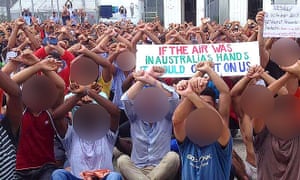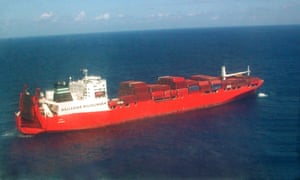In August 2001, at the height of the Tampa crisis – 433 rescued asylum seekers on board a freight ship seeking landfall in Australia – the Australian government made a call to an American bureaucrat, then in Geneva, and asked him to the embassy.
Years earlier, the bureaucrat had been a key architect of America’s policies towards boat-borne asylum seekers seeking protection in the US, and it was this experience Australia wished to mine.
“This particular US policymaker was summoned to the Australian embassy in Geneva,” Dr Daniel Ghezelbash, senior lecturer at Macquarie law school, told a Sydney audience last month, “and was basically in crisis talks for two days providing detailed policy advice, which was the blueprint for the ‘Pacific solution’ and, by extension, the current Operation Sovereign Borders.”
Over several days of talks, a new Australian policy was born: the “Pacific solution”.
“It appears this advice was very influential in shaping the response of the Australian government,” Ghezelbash said. “There is no public record of exactly what was said.”
But the outcomes were apparent: offshore processing centres were established in PNG and Nauru, and asylum seekers entering Australian waters now – as a matter of public policy – found themselves removed from the country.

A final legal sophistry made it possible: parts of Australia were now excised from its own migration zone (before ultimately the whole country was).
In his new book, Refuge Lost: Asylum Law in an Interdependent World, Ghezelbash examines the propensity of states to borrow and adapt policies from other nations to suit their own political ends. Hardline policies towards asylum seekers, he argues, can “spread like wildfire” between countries seeking to burnish their deterrent credentials, and anxious to keep asylum seekers from seeking protection on their shores.
Ghezelbash argues the so-called “Australian solution” – of asylum seeker boat interdiction, mandatory detention, and offshore processing and resettlement, and promoted around the world by Australian ministers – is really the US solution.
The US began mandatory detention of Haitian boat arrivals in the 1980s, years before Australian established the policy in 1992.
Maritime interdiction and pushbacks at sea were also carried out against Haitian asylum seekers by the US from the early 1980s, and Guantanamo Bay was set up as an extraterritorial processing centre, outside the legal protections afforded those who had reached US territory.
“We have entered dangerous times, with respect to states’ attitudes towards the hard-won protections of the refugee convention,” Ghezelbash argued, speaking at the Australian Institute of International Affairs.
“We’ve entered what some have referred to as a deterrence paradigm, where states are continuing to pay lip service to their obligations under the refugee convention, but are bending over backwards to come up with new and innovative ways of keeping asylum seekers from accessing these protections.”
Ghezelbash said hardline policies – like Australia’s and the US’s – can appear attractive to other countries for reasons of political advantage, or the simple fact of keeping asylum seekers out.
“When a state comes up with a policy that pays lip service to those international obligations while achieving the goal of deterrence, it can spread like wildfire amongst governments operating in that paradigm.”
The acting director of the Kaldor Centre for International Refugee Law at the University of New South Wales, Guy Goodwin Gill, said a tendency towards secrecy by governments was anti-democratic, citing the Intergovernmental Consultations on Migration, Asylum and Refugees, which has as its members the Five Eyes countries – Australia, the US, UK, New Zealand and Canada – plus 12 European states.
The organisation has its secretariat in Geneva, but its website is not open to the public, nor its meetings to NGOs or the media.
“We don’t know what they talk about,” Goodwin-Gill said. “We perhaps see the effects of what they talk about, as we witness yet another disastrous policy in relation to asylum seekers emerging in this or that part of the world.
“Why do they meet in secret? What is so attractive about secrecy?
Secrecy tends to enable more executive discretion, Goodwin-Gill argued: “The antithesis of democratic and accountable decision-making.”
Ghezelbash said that, particularly in moments of acute pressure or crisis, states are tempted to look to other states for policy inspiration and imitation.
For Australia, that was Tampa. Facing an impending election campaign, and with more than 400 asylum seekers challenging a narrative over “control” of migration, the Australian government called on the US government bureaucrat – unnamed in the book – seeking policy guidance. The result remains, nearly two decades on, in the manifestation of Operation Sovereign Borders.
But since, Ghezelbash said, the US and Australia have taken contrasting approaches to the promotion of their policies.
“By and large, the US government has gone about these policies quietly, whereas Australian leaders have felt compelled to go on to the international stage and spruik our approach as a model to follow.”
In 2015, deposed Australian prime minister Tony Abbott spoke in London, urging Europe’s leaders to turn boats around and stop people at the continent’s borders.
“It will require some force, it will require massive logistics and expense, it will gnaw at our consciences,” he said. “Yet it is the only way to prevent a tide of humanity surging through Europe and quite possibly changing it forever.”

Abbott said “misguided altruism” was “leading much of Europe into catastrophic error”.
This year in Berlin, the Australian prime minister, Malcolm Turnbull, told German policymakers, “You have to be able to assert your sovereign right to control your own borders.
“We are… absolutely determined to ensure that people do not come to Australia other than with the consent of the government of Australia.”
The protections of the refugee convention are only words, Ghezelbash argued, and their actual effectiveness is shaped with the actions of the states who implement it.
“The risk,” he said, “is we’ll see a race to the bottom as countries compete to deter asylum seekers. This competitive approach creates a vicious cycle, in which governments seek to outdo each other by implementing progressively more restrictive policies.
“If Europe goes down the same path as the United States and Australia, it will be inflicting a mortal wound on the universal principle of asylum and the international refugee protection regime more broadly.”
• Refuge Lost: Asylum Law in an Interdependent World, is published by Cambridge University Press
Story by The Guardian, Support The Guardian here.
,https://www.theguardian.com/australia-news/2018/may/06/a-race-to-the-bottom-how-australia-imported-its-asylum-seeker-policies-from-the-us
http://asylumireland.ml/a-race-to-the-bottom-how-australia-imported-its-asylum-seeker-policies-from-the-us/



No comments:
Post a Comment